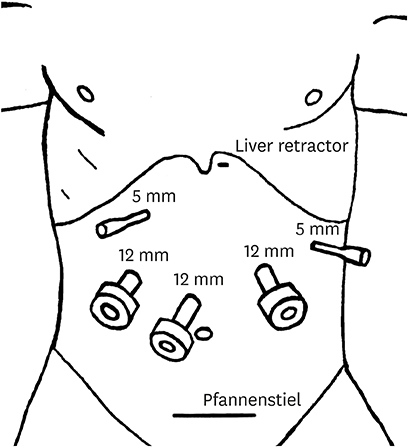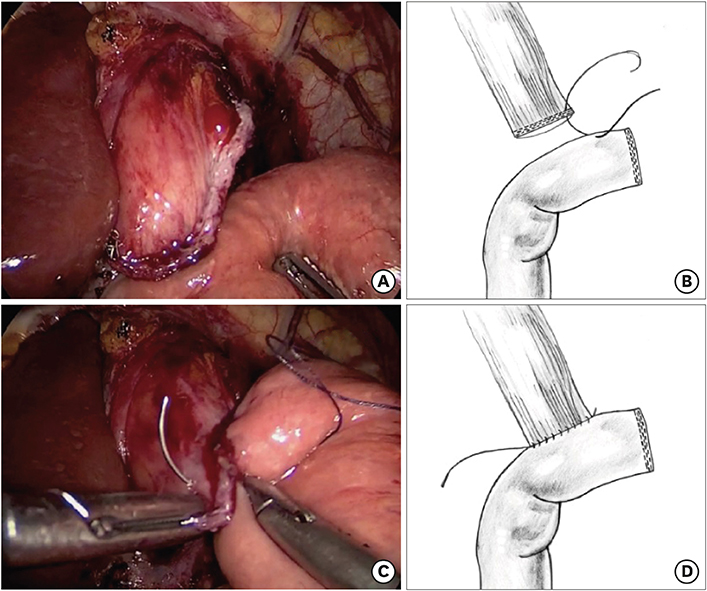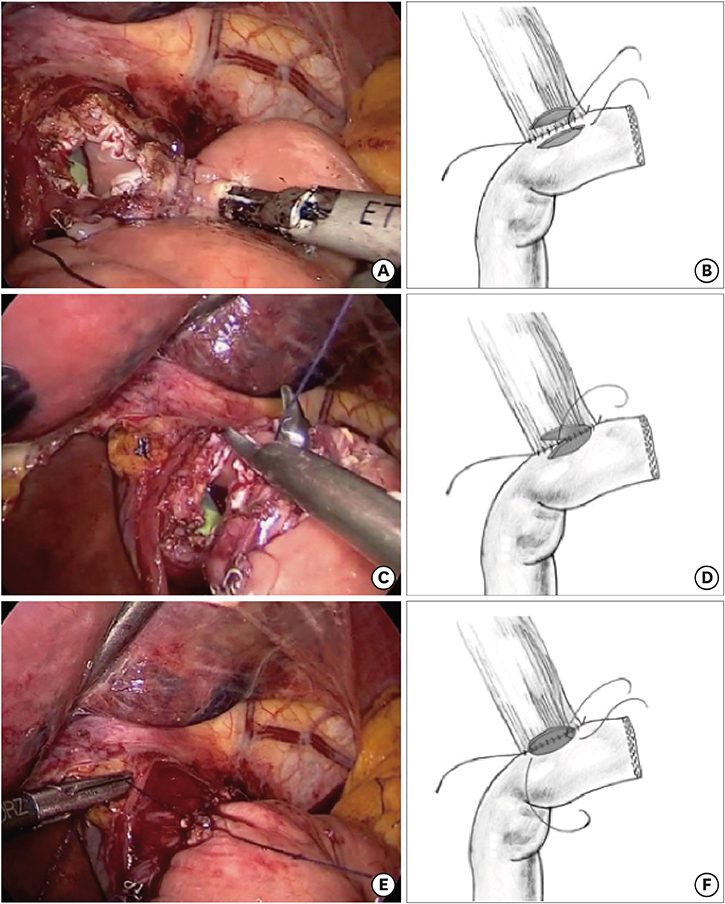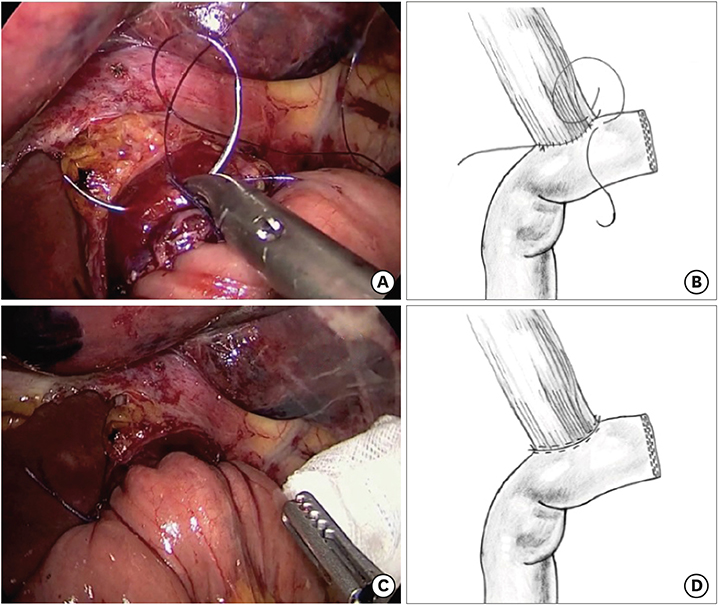J Gastric Cancer.
2017 Sep;17(3):267-276. 10.5230/jgc.2017.17.e26.
Two-Layer Hand-Sewn Esophagojejunostomy in Totally Laparoscopic Total Gastrectomy for Gastric Cancer
- Affiliations
-
- 1Esophagogastric Surgery Unit, Digestive Surgery Department, Hospital Dr. Sotero del Rio, Pontificia Universidad Católica de Chile, Santiago, Chile. enorero@uc.cl
- 2Digestive Surgery Department, Hospital ClÃnico Pontificia Universidad Católica de Chile, Pontificia Universidad Católica de Chile, Santiago, Chile.
- KMID: 2389831
- DOI: http://doi.org/10.5230/jgc.2017.17.e26
Abstract
- PURPOSE
Different esophagojejunostomy (EJ) reconstruction methods are used after totally laparoscopic total gastrectomy (TLTG), and none is considered a standard technique. This report describes a 2-layer hand-sewn EJ technique during TLTG; we also evaluated postoperative morbidity associated with this technique.
MATERIALS AND METHODS
This retrospective cohort study included all consecutive patients who underwent TLTG for gastric cancer (GC) from 2012 to 2016 at 2 affiliated teaching hospitals. All participating surgeons performed standardized intracorporeal 2-layer hand-sewn EJ.
RESULTS
We included 51 patients who underwent TLTG for GC and standardized EJ anastomosis. Twenty-seven (53%) were male, and the median age was 60 (36-87) years. The average operative time was 337±71 minutes and intraoperative bleeding was 160±107 mL. There were no open conversions related to EJ. Postoperative morbidity was observed in 9 (17.0%) patients. There was no postoperative mortality. EJ leakage was observed in 2 patients (3.8%) and 1 patient (1.9%) developed EJ stenosis. Patients with leakage were managed non-operatively and the patient with stenosis required endoscopic dilation. The median length of hospital stay was 8 (6-29) days.
CONCLUSIONS
Two-layer hand-sewn EJ during TLTG for GC is a feasible and safe technique. This method avoids a laparotomy for reconstruction and the disadvantages associated with laparoscopic introduction of mechanical staplers for EJ, and provides an alternative for alimentary tract reconstruction after TLTG.
MeSH Terms
Figure
Reference
-
1. Kitano S, Iso Y, Moriyama M, Sugimachi K. Laparoscopy-assisted Billroth I gastrectomy. Surg Laparosc Endosc. 1994; 4:146–148.2. LaFemina J, Viñuela EF, Schattner MA, Gerdes H, Strong VE. Esophagojejunal reconstruction after total gastrectomy for gastric cancer using a transorally inserted anvil delivery system. Ann Surg Oncol. 2013; 20:2975–2983.3. Moisan F, Norero E, Slako M, Varas J, Palominos G, Crovari F, et al. Completely laparoscopic versus open gastrectomy for early and advanced gastric cancer: a matched cohort study. Surg Endosc. 2012; 26:661–672.4. Norero E, Báez S, Briceño E, Martínez C, Ceroni M, Escalona A, et al. Totally laparoscopic gastrectomy for the treatment of gastric tumors. Rev Med Chil. 2015; 143:281–288.5. Japanese Gastric Cancer Association. Japanese gastric cancer treatment guidelines 2010 (ver. 3). Gastric Cancer. 2011; 14:113–123.6. Dindo D, Demartines N, Clavien PA. Classification of surgical complications: a new proposal with evaluation in a cohort of 6336 patients and results of a survey. Ann Surg. 2004; 240:205–213.7. Edge S, Byrd DR, Compton CC, Fritz AG, Greene FL, Trotti A. AJCC Cancer Staging Manual. 7th ed. New York (NY): Springer;2010.8. Huscher CG, Mingoli A, Sgarzini G, Sansonetti A, Di Paola M, Recher A, et al. Laparoscopic versus open subtotal gastrectomy for distal gastric cancer: five-year results of a randomized prospective trial. Ann Surg. 2005; 241:232–237.9. Viñuela EF, Gonen M, Brennan MF, Coit DG, Strong VE. Laparoscopic versus open distal gastrectomy for gastric cancer: a meta-analysis of randomized controlled trials and high-quality nonrandomized studies. Ann Surg. 2012; 255:446–456.10. Kim W, Kim HH, Han SU, Kim MC, Hyung WJ, Ryu SW, et al. Decreased morbidity of laparoscopic distal gastrectomy compared with open distal gastrectomy for stage I gastric cancer: short-term outcomes from a multicenter randomized controlled trial (KLASS-01). Ann Surg. 2016; 263:28–35.11. Guzmán S, Manrique M, Raddatz A, Norero E, Salinas J, Achurra P, et al. Results of bariatric surgery. Experience over 18 years. Rev Med Chil. 2013; 141:553–561.12. Facy O, Arru L, Azagra JS. Intestinal anastomosis after laparoscopic total gastrectomy. J Visc Surg. 2012; 149:e179–e184.13. Okabe H, Satoh S, Inoue H, Kondo M, Kawamura J, Nomura A, et al. Esophagojejunostomy through minilaparotomy after laparoscopic total gastrectomy. Gastric Cancer. 2007; 10:176–180.14. Chen K, Pan Y, Cai JQ, Wu D, Yan JF, Chen DW, et al. Totally laparoscopic versus laparoscopic-assisted total gastrectomy for upper and middle gastric cancer: a single-unit experience of 253 cases with meta-analysis. World J Surg Oncol. 2016; 14:96.15. Inaba K, Satoh S, Ishida Y, Taniguchi K, Isogaki J, Kanaya S, et al. Overlap method: novel intracorporeal esophagojejunostomy after laparoscopic total gastrectomy. J Am Coll Surg. 2010; 211:e25–e29.16. Okabe H, Obama K, Tsunoda S, Tanaka E, Sakai Y. Advantage of completely laparoscopic gastrectomy with linear stapled reconstruction: a long-term follow-up study. Ann Surg. 2014; 259:109–116.17. Du J, Shuang J, Li J, Li J, Hua J. Intracorporeal circular-stapled esophagojejunostomy after laparoscopic total gastrectomy: a novel self-pulling and holding purse-string suture technique. J Am Coll Surg. 2014; 218:e67–e72.18. Matsuda T, Iwasaki T, Mitsutsuji M, Hirata K, Maekawa Y, Tsugawa D, et al. Surgical outcomes of intracorporeal circular-stapled esophagojejunostomy using modified over-and-over suture technique in laparoscopic total gastrectomy. Surg Endosc. 2015; 29:3386–3391.19. Sakuramoto S, Kikuchi S, Futawatari N, Moriya H, Katada N, Yamashita K, et al. Technique of esophagojejunostomy using transoral placement of the pretilted anvil head after laparoscopic gastrectomy for gastric cancer. Surgery. 2010; 147:742–747.20. Chen K, Pan Y, Cai JQ, Xu XW, Wu D, Yan JF, et al. Intracorporeal esophagojejunostomy after totally laparoscopic total gastrectomy: a single-center 7-year experience. World J Gastroenterol. 2016; 22:3432–3440.21. Varas J, Mejía R, Riquelme A, Maluenda F, Buckel E, Salinas J, et al. Significant transfer of surgical skills obtained with an advanced laparoscopic training program to a laparoscopic jejunojejunostomy in a live porcine model: feasibility of learning advanced laparoscopy in a general surgery residency. Surg Endosc. 2012; 26:3486–3494.
- Full Text Links
- Actions
-
Cited
- CITED
-
- Close
- Share
- Similar articles
-
- Totally Laparoscopic Total Gastrectomy Using Intracorporeally Hand-Sewn Esophagojejunostomy
- Intracorporeal Anastomosis in Laparoscopic Gastric Cancer Surgery
- A Novel Technique of Hand-Sewn Purse-String Suturing by Double Ligation Method (DLM) for Intracorporeal Circular Esophagojejunostomy
- Solo Intracorporeal Esophagojejunostomy Reconstruction Using a Laparoscopic Scope Holder in Single-Port Laparoscopic Total Gastrectomy for Early Gastric Cancer
- Intracorporeal Esophagojejunostomy during Reduced-port Totally Robotic Gastrectomy for Proximal Gastric Cancer: a Novel Application of the Single-Site ® Plus 2-port System





